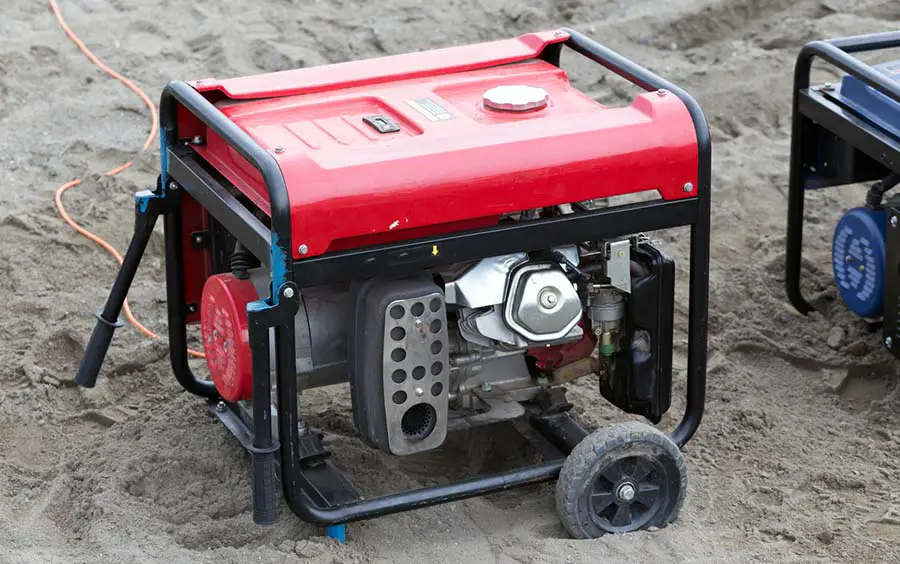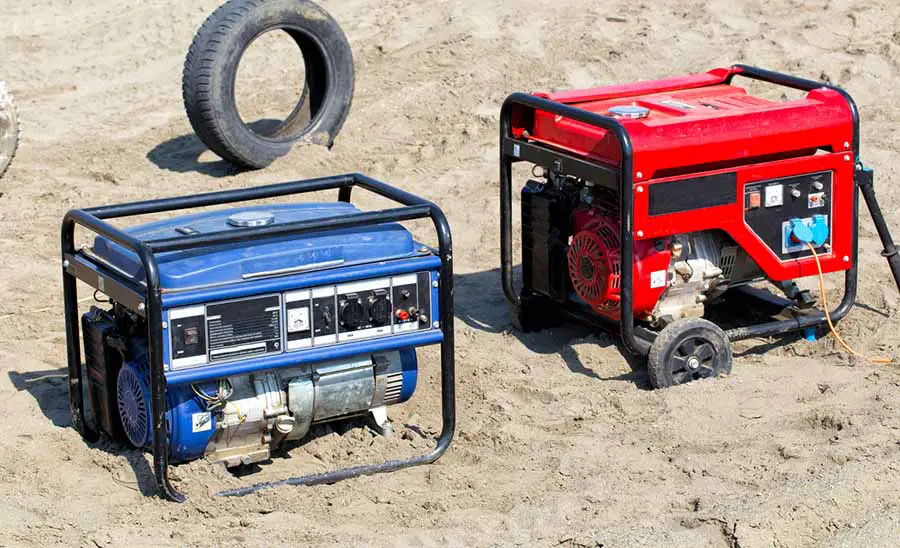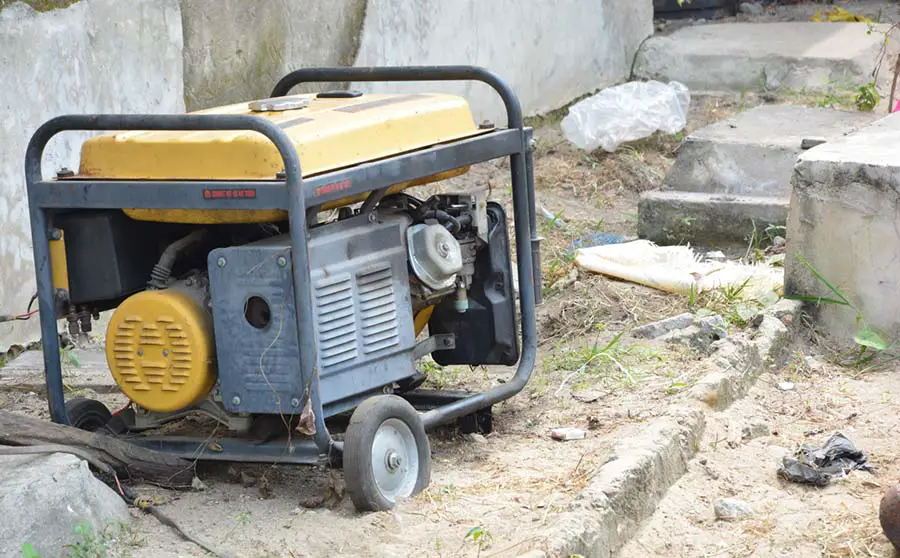
Generally, portable generators will run a gas-powered engine to turn an onboard alternator and generate backup electricity. However, what qualifies as “portable” means different things to different people. Often, people determine portability based on weight and how easy it is to transport the generator without much help from someone else.
Generally, portable generators weigh between 50 and 250 pounds, some weighing slightly less or more. Portable generators weigh 105 pounds on average. Wheels and trailers pulled by vehicles allow some people to consider extremely heavy generators “portable,” even though they weigh thousands of pounds.
This article discusses the various factors that influence the weight of a portable generator. Also, it includes tips on finding the right size of generator for your needs.
Portable Generator Weight Examples
Here are the weights of the generators that made our list of the “10 Most Reliable Generators.” As you can see, portable generators come in various weights, but they tend to fall between 50-250 pounds depending on a variety of factors.
| Generator Brand and Model | Generator Weight |
|---|---|
| Westinghouse Wgen7500 | 200.6 lbs |
| Wen 56200i | 48 lbs |
| Champion 3400 Dual Fuel | 95.7 lbs |
| Honda EU2200i | 47 lbs |
| Honda EU3000iS | 130.7 lbs |
| Champion 75537i | 94.8 lbs |
| Yamaha EF2000iSv2 | 44.1 lbs |
| DuroMax Hybrid XP12000EH | 224 lbs |
| Generac IQ2000 | 46.5 lbs |
| DuroMax XP4850EH | 122 lbs |
Factors That Influence a Portable Generator’s Weight
Since they do not require permanent installation, you can move most portable generators around. In addition, they are best for powering critical appliances during power outages and thus, have a limited run time. You cannot use these engines continuously over several days because they need a break and refueling.
Since you need to move a portable generator around, it is wise to consider several factors that may influence their weight directly or indirectly. That way, you can choose an engine that strikes a delicate balance between portability and functionality.
Below are some of those crucial factors that help determine the total weight of a portable generator:
1. The Power Capacity of a Generator
Most portable generators have an average power capacity of 500W to 17.5kW (17,500W). That extensive range offers homeowners various options on what works for their needs.
When using a 500W generator with a small power capacity, you could power a few lights and a critical appliance or two. On the other hand, a generator with a higher power capacity can power multiple power tools, a 5-top air conditioner, and even an entire three-bedroomed home with all relevant appliances.
There is just one problem: generators with higher power capacity tend to be larger in every way. For example, a Honda EU1000i generator with a peak power capacity of 1000W weighs just 28.7lb. That makes it portable and lightweight. On the other hand, a Honda EB10000 with a peak capacity of 10,000W weighs 403lbs! That is 14 times the weight of its 1kW counterpart!
So, if you intend to find a smaller generator that weighs much less, you need to prioritize what you can power in a blackout and compromise on the power capacity.
2. The Components of the Generator
Portable generators usually have specific components that are necessary for them to function. These include a fuel tank, engine, and alternator. Other essential parts include the frame, a cooling fan, an exhaust system, a battery, and a starter mechanism.
These generator components’ weights vary by brand. Some companies own proprietary technology that has enabled them to develop lighter but more effective portable generators. Usually, the nature of the material one uses significantly affects its weight. Some materials are incredibly lightweight and sturdy. If used within a generator, they help lighten the machine’s overall weight.
For example, in partnership with small business owners, U.S. Army engineers have developed a 100kW generator 3,150lbs lighter, which military people can tow with a Humvee. And yet, that piece of equipment is robust enough to go off the road and survive in one piece.
3. The Presence or Absence of Fuel
When companies state their generator’s weight, they exclude fuel weight. If you intend to move your generator around when it has fuel in it, you must include that extra weight to understand how portable it would be.
Typically, portable generators use propane, diesel, or gasoline. However, some use solar energy to generate electricity. And while the fuel tank capacity is constant, how much extra weight it would add when it’s full varies depending on the gas or liquid fuel it contains since they have varying densities.
For example, suppose you have a portable generator weighing 100 lb when empty with a 2.5-gallon fuel capacity. Propane usually weighs about 4.2 pounds per gallon, diesel weighs about seven pounds per gallon, and gasoline weighs six pounds.
Assuming that we fill the fuel tank to 80 percent capacity to accommodate propane gas and how it tends to expand, and apply that to all fuels, your generator can only fill the fuel tank up to the 2-gallon mark. In that case, propane would add 8.4 lb, diesel would add 14 lb more, and gasoline would increase the generator weight by 12lb.
Therefore, instead of your portable generator weighing 100 pounds, it would weigh at least 108.4lb with propane, 114lb with diesel, and 112lb with gasoline. While the differences may not seem like much at first glance, you will feel every extra pound if you have to carry a portable generator filled with fuel by hand for a significant distance.
4. Type of Generator
Generators vary depending on their energy source and their purpose. And various types of generators have varying weights.
For example, people usually transport continuous generators to remote sites to provide a 100 percent load capacity constant power source. Therefore, they fall under portable generators.
But to withstand such energy demands, these kinds of generators are developed with sturdy and durable materials to withstand the heat, wear, and tear for prolonged periods. However, such materials are likely to have higher densities and, thus, will make the generators pretty heavy.
So, if you opt for these kinds of generators, it would be best to have machinery and vehicles to move it around to a new destination. There is no way you are going to do it by hand.
Finding the Right Portable Generator Size for Your Needs

Since the weight of a portable generator does not exist in a vacuum, it would be wise to ensure you find one that makes your life easier.
You should be able to move it around comfortably. Below are some things you should think about when shopping for the correct size portable generator.
1. The Generator Weight
If weight is the single most crucial factor to consider when choosing a portable generator, it never hurts to prioritize it. After all, you will be the one lugging your generator if it is heavy. So, you can as well find something that suits your needs.
Remember, it’s not just the dry weight of a portable generator that matters. You must also think about its wet weight that factors the weight of fuel in the tank. And if you have no idea how much weight is too much, you can use the existing safety weight limits for the average worker, which stands at 51 pounds under specified conditions.
For example, you could opt for a portable generator of about 45 pounds when camping alone and leave the extra six pounds to accommodate the fuel weight. But if there are two of you, you may be able to carry a portable generator of about 90 pounds, which would have a higher power capacity.
2. The Generator’s Mobility Features
Portability is all about how well you can carry an object. Look out for features that would make it easier for you to move a portable generator from one place to another. Wheels or casters are essential in this case, and some heavier generators tend to have these with them. But many others do not come equipped with these mobility features.
However, so long as you can modify and include them, you can move them around at your convenience, even when heavier. For that reason, it would be best to shop around for compatible wheel kits for the backup generator you would prefer to buy.
You may want to find a portable generator with built-in handles. If you cannot do so, consider one that you can modify and add handles to – preferably foldable handles that make transportation easier. You could purchase generator handles and install them in the latter case or create and add DIY handles.
3. The Generator’s Fuel
Pound for pound, propane weighs the least compared to an equal volume of gasoline. And diesel weighs the most. For that reason, it would make more sense to select a portable generator that uses either propane or gasoline instead of diesel if weight is your biggest concern.
However, these fuel sources have different pros and cons worth considering first. For example, while propane is much lighter, eco-friendlier, cheaper, and does not degrade, it expands significantly when hot, is pretty explosive, and you may need more of it to produce the amount of electricity you desire. Also, it is less available compared to gasoline and diesel.
Gasoline is usually more readily available, produces a decent amount of heat per gallon, is more compact in volume than propane, and creates less noise than diesel. However, it produces more carbon emissions, is relatively expensive, highly combustible, and must burn in higher amounts than diesel to create the same energy, thus making it rather expensive.
On the other hand, diesel produces more heat than gasoline, is more fuel-efficient, and thus, uses less fuel than gasoline, and is less flammable than gasoline. However, it can make generators expensive due to higher maintenance and purchase costs. Also, it is not as widely available and produces significant noise levels. In addition, it has higher carbon emissions than propane but less than gasoline.
So, you may want to consider the individual strengths of each fuel and compare it to their weight before selecting a portable generator suitable for your needs.
4. The Generator’s Price
On average, portable generators cost anywhere from $200 to $5,000, depending on the brand, capacity, and type. But smaller generators tend to cost less, while bigger ones usually cost more.
One way to use price as a guide is to compare portable generators within a similar weight relative to their price and capacity. For example, portable inverter generators tend to throttle their engines up and down instead of operating at full blast. And they usually combine the generator and the engine. They are also lighter, smaller, more compact, fuel-efficient, and quieter.
If you were to judge portable inverter generators based on the standards of regular portable generators, they would fail dismally. That’s because they are more expensive. However, over time, they will save you money. So, it’s fine to consider lightweight inverter generators despite their scary price tags.
5. The Generator’s Capacity

A generator’s power capacity largely determines what can stay on in the absence of power from the electrical grid. And even when weight is a serious matter of concern, it would be wise to weigh that against what your backup generator can power. It is always safer to err on the side of caution and leave an allowance for additional future energy needs.
You could have a portable generator that weighs 30lb and produces 1000W and another that weighs several pounds more and produces twice as much power. If that happens, wouldn’t it be better to consider compromising on your weight restrictions for the ability to power additional appliances?
For example, a Generac 1200i 7671 portable generator with a peak capacity of 1200W weighs 33lb. It also has a 0.8-gallon diesel tank that would add an extra 5.6lb for a total of 38.6 or thereabouts.
On the other hand, a Generac 2500i portable inverter generator with a peak capacity of 2500W weighs 48lbs. It also has a one-gallon gasoline tank which adds an extra six pounds for a total of 54lbs.
While there is a difference of 15.4lbs in weight between the two types of portable generators, the latter’s weight is still under the 70-pound recommendation for lightweight generators for the outdoors and only three pounds higher than the 51-pound safe lifting weight. And yet, it produces at least 200 percent more power.
For that reason, it would be wise to do the math first before using weight as the only decider of what backup generator to buy. You could end up missing a better deal.
6. The Generator’s Safety Features
We have already established that different components within a backup generator add to their weight. But the safety features should be a priority no matter how much weight they add onto the equipment.
Since portable generators are infamous for carbon monoxide (CO) production, you must prioritize those with sensors that detect the gas in question. Some brands have developed CO sensors that shut down portable generators automatically once the gas levels have hit dangerous levels.
So, given a portable generator with a heavier weight that includes the CO sensor, and a lighter version without this safety feature, it would be best to opt for the former. That additional component may add to the weight a bit, but it will ensure you and your loved ones stay safe from carbon monoxide poisoning. Being alive is better than quibbling over a few extra pounds on your portable generator.
7. How Often You Need Backup Power
It is best to think about how often you need backup power when your primary source of electricity goes off. Doing so will help you determine the size and weight of the portable generator you buy.
Excluding extreme events, a typical American household will experience approximately 106 minutes to 118 minutes of power outages annually. However, during storms, expect to lose power for a few hours to a few days, especially if you live in an area prone to extreme weather events.
Remember, higher capacity portable generators that run for longer will be larger and heavier. So, it is up to you to determine what you can do without when the power goes off for more hours or even days.
On the other hand, if you rarely experience power outages, choosing a low-capacity generator with the weight to match would be best.
8. Where Will The Generator Be Placed
Generators work best away from wet conditions. Since you cannot leave them inside your home because they cause carbon monoxide poisoning, you must provide a shelter of some kind outside.
The lighter your generator, the easier it will be to move to a shelter outside when in use and vice versa. If one section is wet, you can quickly move it to a drier area. And since weight and size tend to go hand-in-hand, it follows that smaller portable generators require smaller sheltering structures, thus, making them suitable for use within smaller lots.
So, if your property size is tiny, go light and smaller when choosing a backup generator.
Final Thoughts
How much portable generators weigh is a matter of concern. But it would help if you did not consider the weight of these pieces of equipment in a vacuum.
It is best to think about the factors that may be contributing to that weight and whether they make the heavier generators worth choosing or not. And then, based on all your energy and safety needs, you can find a backup generator that is within an acceptable weight range but is still suitable in other aspects. There is a balance – you just have to find it.

